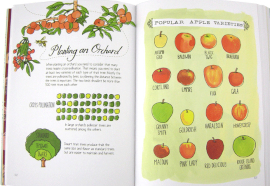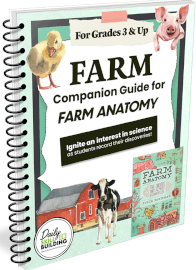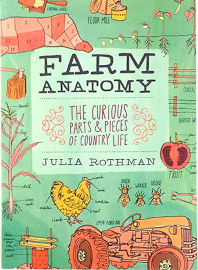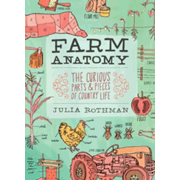Many of us live in urban settings far removed from the land and don’t realize how much science a person learns just by living on a farm. Two books, Farm Anatomy and Farm: Companion Guide for Farm Anatomy, bring the farm to us in this course for grades three through twelve. While it touches on many science topics, it’s more about practical knowledge that can be applied on farms and elsewhere.
Farm Anatomy
Farm Anatomy: The Curious Parts & Pieces of Country Life by Julia Rothman (Storey Publishing) is a 222-page book filled with the author’s full-color illustrations as well as her own printed and cursive text. Perhaps it’s because I’m not familiar with farms, but I found the book both fascinating and instructive. It’s the kind of book all ages might enjoy exploring.
It covers far more topics than I expected. We learn about the expected topics like soil, seeds, crops, gardens, and farm animals. But we also read about topics like building fences and felling trees (including bucking, splitting, and stacking the wood). Later in the book, it shifts to the kitchen with instructions for making dandelion wine, homemade bread and cheese, smoked and dried meats, and much more.
 There’s something for everyone in this book. The mechanically minded might be intrigued by the section about tractors that shows and explains the different contraptions a farmer might connect to it, like plows, harrows, drills, and balers. Those who like to build might be interested in the variety of ideas for building chicken coops, barns doors, and gates. Animal lovers might enjoy learning about cows, goats, chickens, and other farm animals. The horticulturist can learn about the proper times to plant various seeds, crop and garden rotations, building a “Tater Tower,” good and bad bugs for the garden, and much more. Cooks might love the many recipes, such as those for Whole-Wheat Granola Coffee Cake, Freezer Dills, and Maple Fudge. Arts-and-crafts aficionados might try projects in the final chapter, like yarn making (carding, spinning, and dyeing), pressing flowers, making cornhusk dolls, creating a rag rug, candle making, and quilting.
There’s something for everyone in this book. The mechanically minded might be intrigued by the section about tractors that shows and explains the different contraptions a farmer might connect to it, like plows, harrows, drills, and balers. Those who like to build might be interested in the variety of ideas for building chicken coops, barns doors, and gates. Animal lovers might enjoy learning about cows, goats, chickens, and other farm animals. The horticulturist can learn about the proper times to plant various seeds, crop and garden rotations, building a “Tater Tower,” good and bad bugs for the garden, and much more. Cooks might love the many recipes, such as those for Whole-Wheat Granola Coffee Cake, Freezer Dills, and Maple Fudge. Arts-and-crafts aficionados might try projects in the final chapter, like yarn making (carding, spinning, and dyeing), pressing flowers, making cornhusk dolls, creating a rag rug, candle making, and quilting.
The instructions for recipes are complete, but those for other projects are not as detailed, and you’ll need to get complete instructions elsewhere. For instance, I’d never heard of a "Tater Tower” for growing potatoes in a compact space. It’s a box-like construction that begins with side boards only on the lower part. As potatoes grow, you add soil and side boards (screwed to the uprights). To harvest, you unscrew the side boards at the bottom and begin removing potatoes from the bottom of the box first. The concept is simple enough to do it yourself from the illustrations, but it doesn’t give you details. (I found many variations online, some with video instructions.) Likewise, the quilting instructions give you an idea of how it is done, but they are too minimal for beginners.
This is the sort of book that you can read either straight through or selectively since chapters are not dependent on one another. Suggested books and websites at the back of the book might be investigated if students want to go deeper into some topics.
Farm: Companion Guide for Farm Anatomy
 Farm: Companion Guide for Farm Anatomy, published by Daily Skill Building, turns Farm Anatomy into a course by providing notebooking activities for students to draw, label, and write about what they have learned. For example, page 2 asks students to “Draw the pie chart that shows the makeup of healthy topsoil and label each section.” On the next page, they are told, “Read pages 14-15 of Farm Anatomy and fill in the blanks with the information you learn." Two questions follow about groups of essential mineral nutrients and good crops for replenishing nitrogen in the soil. Students are provided space to draw and lines on which to write answers.
Farm: Companion Guide for Farm Anatomy, published by Daily Skill Building, turns Farm Anatomy into a course by providing notebooking activities for students to draw, label, and write about what they have learned. For example, page 2 asks students to “Draw the pie chart that shows the makeup of healthy topsoil and label each section.” On the next page, they are told, “Read pages 14-15 of Farm Anatomy and fill in the blanks with the information you learn." Two questions follow about groups of essential mineral nutrients and good crops for replenishing nitrogen in the soil. Students are provided space to draw and lines on which to write answers.
The Companion Guide focuses primarily on comprehension. Half or more of the activities involve drawing based on images in Farm Anatomy. Younger children should be able to do the drawings with varying degrees of accuracy and might need help writing answers to questions. Older students can work independently through the entire study.
You can also purchase a Junior Notebook digital add-on bundle with 103 pages for younger students. These include coloring and drawing pages rather than questions and boxes designated for specific drawings.
Pages for each chapter include one for parents to write down possible field trips and other activity ideas as they tailor the course to suit their children’s interests.
Note that Julia Rothman has written three books similar to Farm Anatomy: Nature Anatomy, Ocean Anatomy, and Food Anatomy, and Daily Skill Building has published a Companion Guide for each. You can save on the Companion Guides by purchasing all four as a bundle.
Summary
Farm Anatomy can be read on its own and turned into a course by using Farm: Companion Guide for Farm Anatomy. I think the complete course works best for those in grades four through eight, then you can add the Junior Notebook for those in third grade or even younger. It’s more difficult to slot the course into the high school curriculum, so I’d let teens read Farm Companion selectively on their own.










